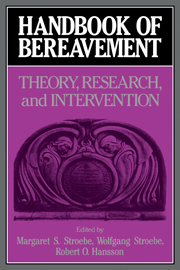Book contents
- Frontmatter
- Contents
- Contributors
- Preface
- Part I Introduction
- Part II The phenomenology and measurement of grief
- Part III Current theories of grief, mourning, and bereavement
- Part IV Physiological changes following bereavement
- Part V The psychological, social, and health impacts of conjugal bereavement
- Part VI Grief reactions to different types of loss
- 18 Loss and recovery
- 19 The death of a child is forever: The life course impact of child loss
- 20 Children's reactions to the death of a parent
- 21 Bereavement following death from AIDS: Unique problems, reactions, and special needs
- 22 Sleep and dreams in well-adjusted and less adjusted Holocaust survivors
- Part VII Coping, counseling, and therapy
- Part VIII Conclusions
- References
- Author index
- Subject Index
18 - Loss and recovery
Published online by Cambridge University Press: 04 May 2010
- Frontmatter
- Contents
- Contributors
- Preface
- Part I Introduction
- Part II The phenomenology and measurement of grief
- Part III Current theories of grief, mourning, and bereavement
- Part IV Physiological changes following bereavement
- Part V The psychological, social, and health impacts of conjugal bereavement
- Part VI Grief reactions to different types of loss
- 18 Loss and recovery
- 19 The death of a child is forever: The life course impact of child loss
- 20 Children's reactions to the death of a parent
- 21 Bereavement following death from AIDS: Unique problems, reactions, and special needs
- 22 Sleep and dreams in well-adjusted and less adjusted Holocaust survivors
- Part VII Coping, counseling, and therapy
- Part VIII Conclusions
- References
- Author index
- Subject Index
Summary
Grief results when individuals lose certain “primary” relationships, but not when they lose others. Individuals who have lost emotional partners or children exhibit intense and prolonged grief (Glick, Weiss, & Parkes, 1974; Wortman & Silver, 1987). So do individuals who have lost parents to whom they were unusually close (Horowitz et al., 1984b). Grief, although to a lesser degree, is also exhibited by some who lose therapists, teachers, or other guides (Weiss, 1973b). In contrast, intense or prolonged grief is only rarely exhibited in response to the loss of friends, family members who live in different households, or colleagues or co-workers.
Relationships with spouses, children, siblings, friends, and colleagues are all “primary” in that they are close, face-to-face, emotionally important, and formed with a specific relational partner. Yet they divide into two distinct classes of relationships: those whose loss triggers grief and those whose loss does not.
The first class of relationships, those whose loss triggers grief, I will call relationships of attachment. The second class I will call relationships of community. Severe and persisting distress follows loss of any single relationship of the first class but not the loss of any single relationship of the second class. The death of a spouse or a child tends to be followed by years of grief; the death of a friend, a colleague, or an adult sibling living in a different household tends to be followed by distress and sadness but not by severe and persisting grief.
- Type
- Chapter
- Information
- Handbook of BereavementTheory, Research, and Intervention, pp. 271 - 284Publisher: Cambridge University PressPrint publication year: 1993
- 39
- Cited by

